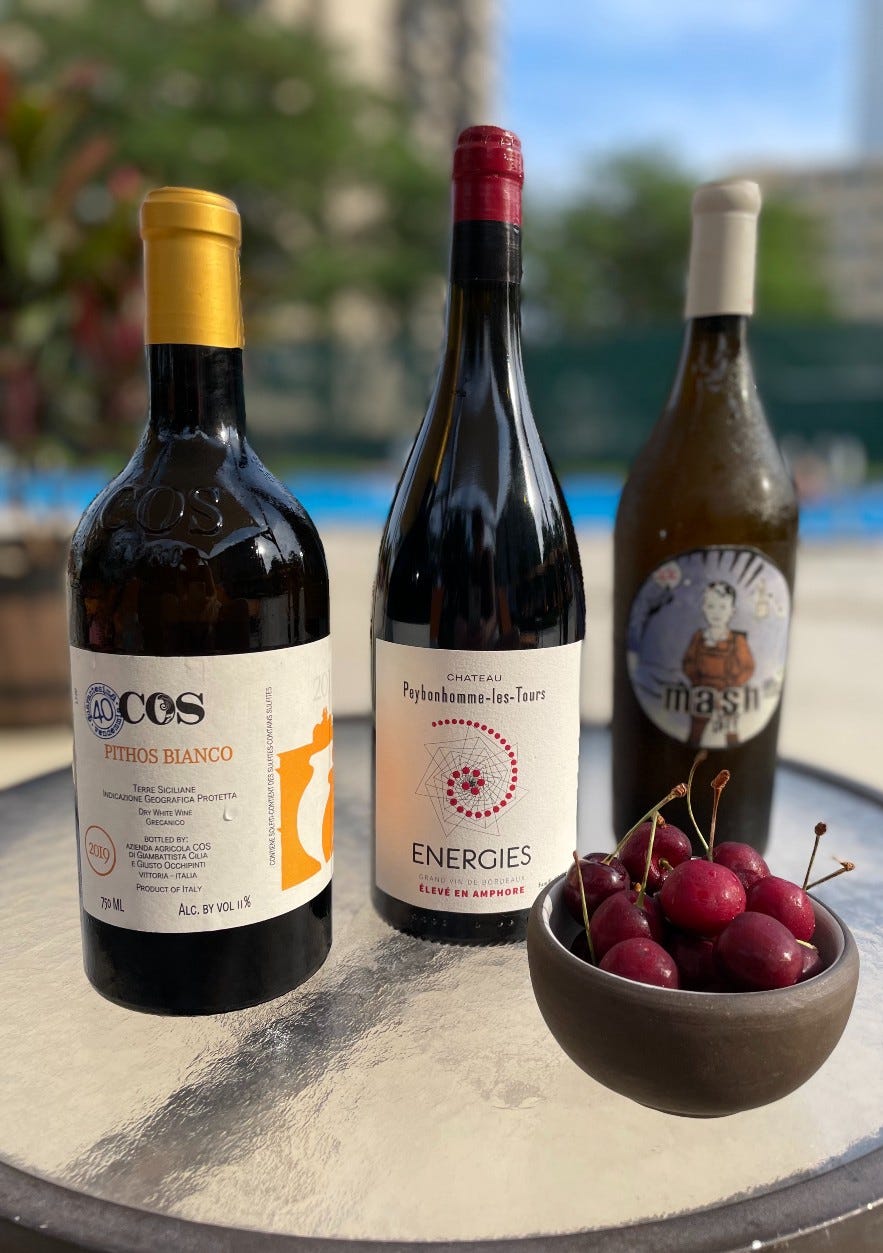Getting to Know Amphora-Aged Wines
Winemakers are rediscovering clay vessels — and making some delicious wines along the way
Wine and clay. Those are the two passions that unite my household. I’m the vinous side of the equation and my husband Jono Pandolfi makes ceramic dinnerware. Our businesses have always intersected in the realm of hospitality — him supplying plates and bowls to restaurants and hotels, and me writing about wine and wine personalities. But they’ve rarely overlapped completely.
Except in the case of clay-fermented and clay-aged wines.
These wines are made in clay vessels instead of the typical stainless steel or wooden barrels. As it turns out, clay is a fascinating compound — it does some cool things to wine.
I’m giving a talk about clay-made wines at Jono’s Brooklyn Summer Shop, so I selected some favorites to share, including a skin-contact white, an orange wine, and a textural red. Let’s dive in!
What to Know
It seems that clay-fermented and clay-aged wines are popping up a lot these days. Winemakers around the globe are experimenting with these vessels, but the technique has ancient roots. Clay vessels have been used to make wine in the Republic of Georgia for some 8,000 years, and for thousands of years elsewhere.
First off, a Q: What is clay?
A: It’s an earthen material composed of fine mineral particles. It’s soft when moist, hard when fired, and used mainly for pottery, bricks, and tiles. Clay comes in many colors, including red, grey, and tan, depending on its mineral content.
When fired to low temperatures, clay becomes terracotta, or earthenware; it’s porous, meaning that liquid seeps into it and allows micro-oxygenation. High-fired clay (with low to no oxygen exchange) is called stoneware or porcelain.
Earthenware vessels are mostly used for wine because winemakers desire that micro-oxygenation. It’s one of the key benefits of these vessels over stainless steel. Micro-oxygenation helps to tame a wine’s astringency and improve its texture and aromas.
Clay vessels are also neutral, meaning they impart no additional flavors to a wine (though they can soften a wine’s acidity). That’s one reason natural winemakers turn to clay vessels for making skin-fermented wines over wooden barrels — the aromas and flavors of the grapes are preserved without oak influence (i.e. flavors of vanilla and spice).
TL;DR — When done well, clay-made wines have uncommon fruit purity, with intense flavors and textural depth.
Clay vessels go by many names: Qvevri in Georgia, amphora in Italy, talha in Portugal, and tinaja in Spain — and dolium and amphora more generally. They come in a wide range of sizes and shapes, from smaller conical amphorae to massive egg-shaped qvevri.
Georgia’s famous amber wines are made in qvevri, earthenware pots big enough for a person to stand up in (often 1,000 liters or larger). They’re lined with beeswax to make them less permeable, and buried underground. Wines are fermented in the vessel, with grape skins remaining in contact with the wine for several months. That extended skin maceration turns the white wines orange.
Elsewhere, producers use a variety of vessels. One of my favorite Sicilian producers is COS, whose orange wine Pithos Bianco is highlighted below. COS uses 400-liter terracotta jars buried in the ground to ferment and age the wine. Then there are vintners like Fontodi, in Italy’s Chianti region, who make amphorae from the clay on their estate and age their wines in the vessels — further deepening the wine’s connection to its terroir. And there’s even a winemaker in Oregon, Andrew Beckham, who makes his own fermentation vessels from clay.
That’s all to say: There’s energy and excitement around the use of clay vessels for making wine, with winemakers experimenting in real-time, learning how to use the vessels to make memorable wines.
My key takeaway? Many clay-made wines are distinctive and delicious, a testament to the wisdom of the ancients. In this case, what’s old is new — and worth seeking out.
Three to Try
Chateau Peybonhomme-Les-Tours “Energies,” Bordeaux 2018 ($25)
Top pick. This biodynamic Bordeaux wine is a new take on the region’s red blends. It’s made from Malbec, Merlot, and Cabernet Sauvignon grapes that are fermented then aged in clay amphora for 12 months. I find it completely fascinating — fresh and flavorful, yet with depth and richness. There are juicy blackberries and black currants with dried thyme and black pepper, and a velvety texture with black tea tannins.
COS, Pithos Bianco, Sicily 2019 ($32)
COS is a benchmark biodynamic producer in Sicily that makes celebrated natural wines. Pithos (the Greek word for amphora) is fermented and aged in amphora. The wine is made from the Garganega grape, with 20 days of skin contact during fermentation, followed by seven months of aging before bottling. A brassy orange color, it is smooth and sippable, with a complexity of flavors, from golden apple and grapefruit zest, to almonds and white tea.
Pittnauer, Mash Pitt, Burgenland, Austria ($33)
This skin-fermented white is a hazy, golden blend of Sauvignon Blanc, Gruner Veltliner, and Chardonnay. It’s aromatic (lemon, iris, honey), with fresh acidity, green tea tannins, and a yogurty tang. The wine comes from Gerhard and Brigitte Pittnauer, excellent biodynamic producers in Austria. The grapes are macerated on their skins for 20 days, followed by spontaneous fermentation and aging in a 1,000-liter amphora for 8 months.




